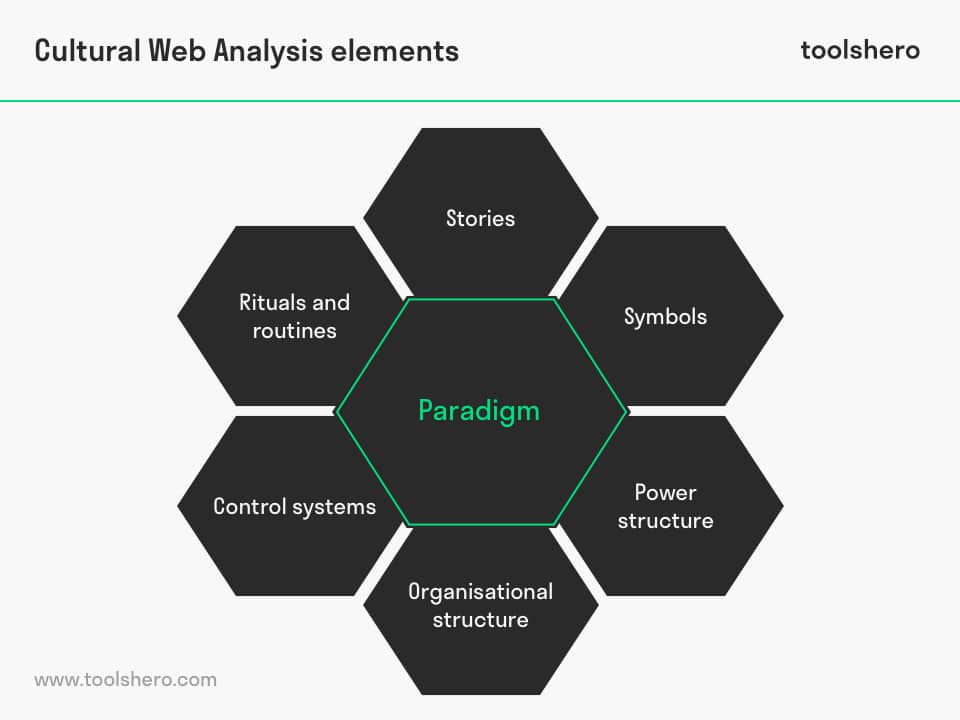Cultural Web Analysis

Cultural Web Analysis: this article provides a practical explanation of the Cultural Web Analysis. After reading this article, you will understand the basics of this powerful management and organisational culture tool.
What is the Cultural Web Analysis?
The Cultural Web Analysis is a model where the organisational paradigm, convictions and assumptions within an organisation are clarified by means of a coherent whole of six elements.
The paradigm, the organisational culture, exists within the web.
The Cultural Web Analysis stimulates the way employees within an organisation interact with each other, how they handle their work, but also how the organisation as a whole relates to the outside world and the various cultures that exist in the outside world.
By analysing the six elements, the big picture of the organisational culture is formed. This creates clarity regarding the questions: what works, what does not work, how do we approach our work and how do we work together with other organisational cultures? There is a great need to manage the organisational culture because this affects the strategy and performances of the organisation.
The Cultural Web Analysis was developed by Gerry Johnson and Kevan Scholes in 1992. Before the paradigm and its six elements are described, Johnson and Scholes’ ideas regarding organisational culture are discussed.
Cultural Web Analysis : the culture context
A culture is shaped over a longer period of time, which makes it a fairly abstract subject. The same is true for organisational cultures.
Because the shaping of a culture occurs unnoticed, the obvious character of an organisational culture hardly receives any attention. Only when strong impulses bring about changes in the organisation, both from within and outside the organisation, does an organisational structure become important.
Nevertheless, the obvious assumptions that are made regarding an organisational culture could play an important and impeding role when the organisation finds itself in a merger, for instance, and various organisational cultures must be joined.
As the policy of an organisation and their values are often documented, little confusion usually arises where that is concerned. Cultural aspects are a lot harder to put into words.
The organisational culture ensures that people align their behaviour to each other and that similarities in thinking and acting arise between these people. This happens within the organisations, but also in the external environment in which they operate.
As a result, a network of organisations sharing the same values and therefore also displaying the same behaviour arises. Which decisions the organisations take depends on the organisational culture and the network they are a part of. Johnson and Scholes distinguish two cultural contexts:
1. The regional cultural context
The regional and national context must be considered, as this greatly influences the stakeholders’ expectations. The nation or region is based on social values that may differ from the values of the organisation.
Particularly for internationally active organisations, it is important to understand and respect the regional culture.
2. The organisational context
This refers to the similarities between organisations within the network. The organisations naturally have their own visions and missions and therefore also have their own strategies, based on their specialties.
The outside world must take into account these strategies to effectively do business with the organisations. The organisational context says something about the way in which organisations are managed and must be treated.
An effective organisational culture is characterised by:
- Like-mindedness among the employees
- High level of adaptibility and competence of the employees
- A concrete, clear mission, recognisable to everyone, that arises from the objectives and strategy
- A high level of involvement of the employees
Cultural Web Analysis: the six elements of organisational culture
Johnson and Scholes referred to the coherent whole of natural assumptions that form the paradigm by the term ‘Cultural Web’. The paradigm consists of six types of physical and observable utterances of organisational culture.
1. Stories
These are the stories of events that are constantly talked about within the organisation. These stories are kept alive by the employees and are passed along to newcomers. The stories are told in the hallways, in the canteen, or in the smoking area and are often about the heroes, villains, successes and failures of an organisation. The stories reveal much about the values that apply within the organisation.
2. Symbols
The symbols are about recongisable expressions of the organisation, such as the office building, the corporate identity, the logo, the company cars, the functions, the dress code and the use of language.
3. Power structure
The power structure is directly related to the paradigm, because the most powerful people within an organisation are deemed to have the most direct influence on the core assumptions and ideas within an organisation.
4. Organisational structure
The organisational structure includes the hierarchical composition of the organisation and the relationship between people from these various layers of the organisation. The informal and unwritten power structures are also part of the organisational structure.
5. Control systems
This element is regarding the way in which the organisation is being managed and controlled. This includes the financial systems, the quality systems and rewards. How these rewards are determined and how these are distributed within the organisation also falls under control systems.
6. Rituals and routines
Rituals are the events of an organisation in which they emphasise what is truly important to them and how they handle matters. Examples of this are: Friday afternoon drinks, training courses, promotions and the recruitment and selection policy of the organisation.
Routines that reveal much about the way employees interact with each other and others both within and outside the organisation.
Cultural Web Analysis: sub-cultures within an organisation
The Cultural Web Analysis theory by Johnson and Scholes assumes a strong organisational culture. In practice, however, this is not always the case and there are often countless sub-cultures.
A study by Van Maanen and Barley (1984) shows that organisations with a general culture only occur sporadically. The organisational culture Johnson and Scholes’ Cultural Web refers to is mainly about the central dominant culture that is based on the shared values. No matter how strong the central culture is, organisations will always have deviating cultures.
A single dominant culture can only develop when all employees regularly interact with each other and are confronted with the same problems and people.
However, labour specialisation weakens this structure and joint values are shared less often. As a result, a sub-culture may arise within a single department. They do share the joint assumptions within an organisation, but also have deviating, specific ideas regarding their vision or their tasks.
It is highly important that these sub-cultures do not isolate themselves from the shared culture too much, because a lack of union often breads counter-productivity and rivalry. Managing various cultures is therefore a challenge that many CEOs struggle with.
Cultural Web Analysis summary
The organisational culture, big or small, influences the organisation’s performance. Despite the fact that not many organisations stimulate or manage their own culture, the culture is very telling when it comes to the organisation’s future.
Johnson and Scholes’ Cultural Web shows that the organisational culture is related to both the way in which employees interact with each other and the way in which the organisation interacts with the outside world.
Despite the fact that a strong organisational culture stimulates unity, there are always sub-cultures that create division. The benefits that a strong organisational culture brings are difficult to replicate and provide the organisation with a strong competitive advantage.
It’s Your Turn
What do you think? Do you recognise the explanation about the Cultural Web or do you have anything to add? What do you feel are the factors that contribute to a healthy and effective organisational culture? How will you use the Cultural Web to map the culture within your organisation?
Share your experience and knowledge in the comments box below.
More information
- Johnson, G. (1992). Managing strategic change—strategy, culture and action. Long range planning, 25(1), 28-36.
- Sun, S. (2009). Organizational culture and its themes. International Journal of Business and Management, 3(12), 137.
- McDonald, S., & Foster, R. A. (2013). The use of Johnson’s Cultural Web to improve understanding of organisational culture: a critical review. International Journal of Management, 30(4), 340.
How to cite this article:
Janse, B. (2018). Cultural Web Analysis. Retrieved [insert date] from Toolshero: https://www.toolshero.com/management/cultural-web-analysis/
Published on: 08/23/2018 | Last update: 03/25/2022
Add a link to this page on your website:
<a href=”https://www.toolshero.com/management/cultural-web-analysis/”>Toolshero: Cultural Web Analysis</a>







